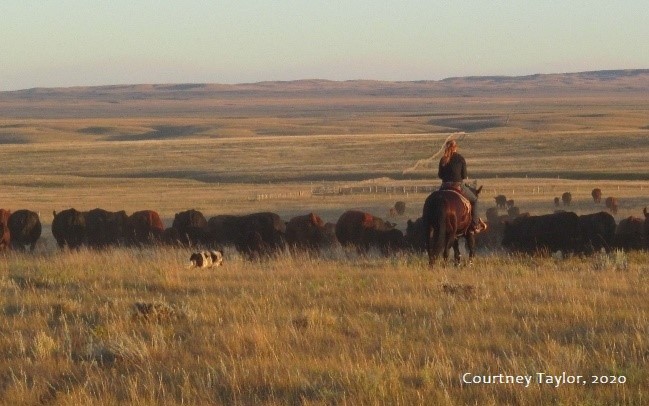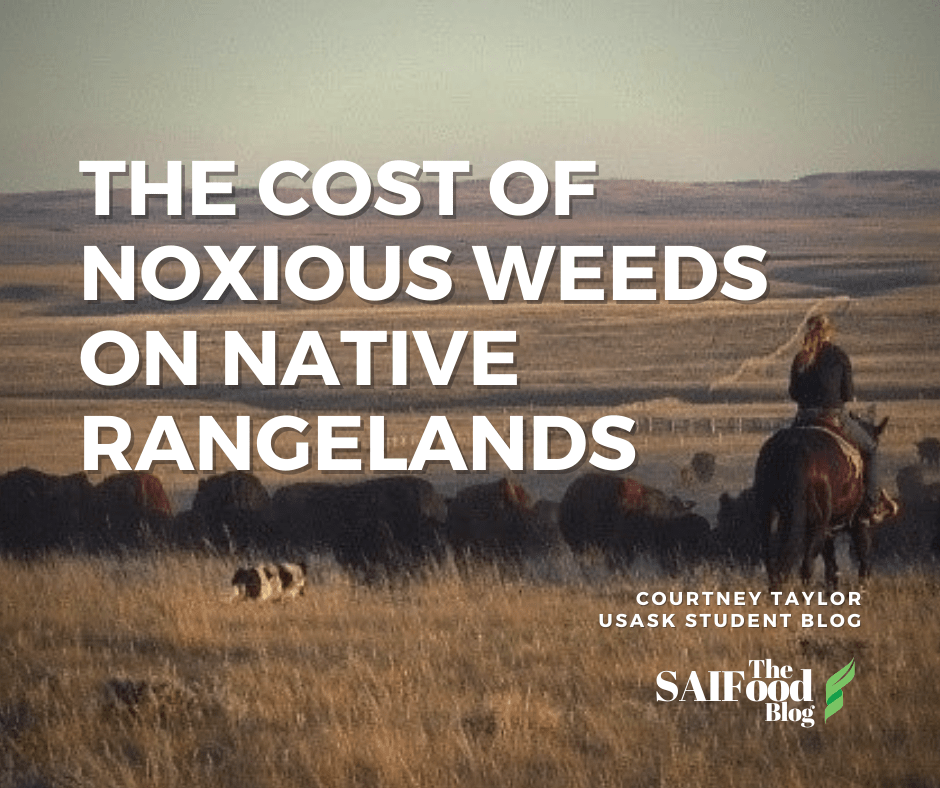By Courtney Taylor, University of Saskatchewan
North American rangelands are a diverse and sensitive ecosystem that provides great value to humanity by protecting ecological biodiversity, and the economic well-being of those who depend upon it for forage, tourism, or recreation opportunities. The sanctity of these diverse habitats is threatened by invaders that humans can unintentionally and unknowingly carry into previously pristine areas. As their human hosts travel so does one of the largest threats to the conservation of native rangelands; Invasive weed species and the biological pollution caused by the anthropogenic breakdown of geographic barriers (Mcknight, 1993).

Anthropogenic species introduction and examples
Humans can introduce weeds species to areas through many pathways including purposeful introduction for aesthetic, medicinal, or agricultural purposes. Weed species may also be unintentionally introduced through international travel and trade, and environmental modification that facilitates the establishment of non-native species.

Biologically many of these introduced plants can outcompete the native species due to their aggressive growth strategies and the lack of natural predators in their introduced settings. These invasive plants can create aggressively spreading monocultures that displace the native plant systems that would otherwise enable the growth and maintenance of biodiversity.
For example, Canada Thistle and Leafy Spurge are human-introduced invasive species that each have extremely aggressive mechanisms of growth and reproduction (Gucker, 2010.; Donald 1994). Both plants employ a creeping root system, are allelopathic (they excrete toxins that inhibit the growth of plants surrounding them) and reproduce via seed with unique characteristics that aid in widespread seed dispersal (Gucker, 2010.; Donald, 1994). These methods include a pappus for wind-aided seed dispersal in the case of Canada thistle (Donald,1994). In Leafy Spurge the three-sided seed capsule has been observed to explode sending seeds shooting near 5 meters from the mother plant (ISCBC, 2017).
The extent of the issue
Keeping with the Leafy spurge theme, the first Leafy Spurge collection in Canada was made in 1899 in Ontario (Dunn, 1985). By 1950 it had been found in every province but Newfoundland (Selleck, 1962). By the early 1900s, Spurge was widespread in Canada and the United States (Leitch 1996). In 1999, Manitoba estimated 340,000 acres of leafy spurge infested land with a direct cost approaching $20 million associated with the resultant decrease in productivity (LSSG, 1999). In 2010 a study based in Manitoba estimated the infestation at 1.5 million acres with a whopping $40 Million annual loss in productivity (Rural Development Institute, 2010). As of 2005, the United States had 4.6 million acres of land infested and consequently degraded by Leafy Spurge (Lym, 2005).
If these numbers seem concerning, it is because they are. This is only one species, in 2008 the CFIA estimated that there are 486 invasive alien plant species in Canada.

Strategies for management and mitigation
Unfortunately, there is no magic cure for invasive weed infestations on North American rangelands. An integrated management system is required to even keep populations from expanding, rarely with any real hope of complete eradication. A variety of management tactics can be employed on native rangeland but depending on the target weed’s taxonomy some may be more effective than others. Unlike in a monoculture cropping system, a blanket herbicide application is not ideal for native rangeland as any broadleaf herbicide that would target Leafy Spurge would also kill the native broadleaf plants. This would severely decrease the biodiversity that the managers are trying to maintain.
Common methods to control invasive weed species include grazing, where animals are trained to eat the target weed (Leafy Spurge), bio-control, where animals, usually, insects or pathogens, are released to combat the weeds (Canada Thistle and Leafy Spurge), selective herbicide application, and in some cases hand picking. Integrated weeds control systems are often costly and labour-intensive due to the necessary labour and financial inputs. These costs vary depending on the treatment methodology and size of the infestation. Without intensive and decisive action, however, the costs both economic and ecological can grow exponentially as proven by the 1999 study conducted in Manitoba (LSSG, 1999). The most efficient and effective measure to prevent the spread of invasive weeds is to prevent their introduction to native rangeland ecosystems.
Government policies surrounding invasive species

Policies that prevent the introduction and transport of invasive species can mandate the control of infestations and are in place in Canada in multiple forms. On a federal level, the Seeds Act and the Plant Protection Act grants the CFIA the authority to “protect plant life… by preventing the importation, exportation and spread of pests and by controlling or eradicating pests in Canada” (Plant Protection Act, 1990). Each province can also designate certain weeds to be of high concern and can mandate the control of these weeds (Weed Control Act, 2010).
Responses from the federal, provincial, and municipal governments might include surveys, management programs, monitoring, and regulations but on an individual basis, each of us can be aware of our potential to introduce invasive species (CFIA, 2008). Just a handful of seeds have the potential to cost billions of dollars in lost revenue and control costs and endanger the biological sanctity of the remaining native rangelands of North America.
Conclusion

North American rangelands are a diverse and sensitive ecosystem that is under siege from aggressive invaders. Humans have introduced a foe that the native flora are wholly unprepared to combat and now we must step up to protect the sanctity of our native rangelands. A controlled and focused effort to mitigate the spread of invasive weeds is necessary to combat the degradation of our native rangelands. The cost of inaction far outweighs the cost of a successful integrated management approach which the government, at various levels, has already acknowledged with the various pieces of the legislature concerning the control of invasive weed species. Acknowledgment, action, and education on the dangers of invasive weeds are integral to the preservation of native rangeland.
[su_accordion][su_spoiler title=”References” open=”no” style=”default” icon=”plus” anchor=”” class=””][su_list icon=”icon: check” icon_color=”#47907C”]
- Invasive Species Council of British Columbia. (2017) Leafy Spurge Euphorbia esula Fact Sheet. Accessed from https://bcinvasives.ca/documents/Leafy_Spurge_TIPS_2017_WEB.pdf on October 25, 2020.
- Canadian Food Inspection Agency. (2008) Invasive alien plants in Canada: Summary report. Plantes exotiques envahissantes au Canada: Rapport sommaire. Ottawa, Ontario: Canadian Food Inspection Agency.
- Donald, W. W. (1994). The biology of Canada thistle (Cirsium arvense). Reviews of Weed Science 6: 77-101.
- Dunn, P. H. (1985). Origins of leafy spurge in North America. Leafy Spurge, Monograph series of the Weed Science Society of America. ed. Alan K. Watson, 1985. Chapter 2 (3):7-13,
- Government of Canada. (1990). Plant Protection Act. Accessed from https://laws-lois.justice.gc.ca/eng/acts/p-14.8/FullText.html.
- Gucker, Corey L. (2010). Euphorbia esula. In: Fire Effects Information System, [Online]. U.S. Department of Agriculture, Forest Service, Rocky Mountain Research Station, Fire Sciences Laboratory Available: https://www.fs.fed.us/database/feis/plants/forb/eupesu/all.html.
- Leafy Spurge Stakeholders Group. 1999. Leafy Spurge Impact Assessment. Accessed from https://www.brandonu.ca/rdi/files/2011/03/EconomicImpactAssessment2010.pdf on October 23, 2020.
- Leitch, J. A., Leistritz, F. L., & Bangsund, D. A. (1996). Economic effect of leafy spurge in the upper great plains: Methods, models, and results. Impact Assessment Bulletin, 14(4), 419–433.
- Lym, R. G. (2005). Spurge family: Euphorbiaceae. Leafy spurge, Euphorbia esula L. In C. A. Duncan and J. K. Clark, eds. Invasive Plants of Range and Wildlands and their Environmental, Economic, and Societal Impacts. Lawrence, KS: Weed Science Society of America. In press.
- McKnight, B.N., ed. (1993). Biological Pollution: The Control and Impact of Invasive Exotic Species. Indianapolis IN: Indiana Academy of Science. 243-250.
- Rural Development Institute, R. (2010). ECONOMIC IMPACT ASSESSMENT OF LEAFY SPURGE IN SOUTHERN MANITOBA FINAL REPORT. Retrieved October 25, 2020, from https://www.brandonu.ca/rdi/files/2011/03/EconomicImpactAssessment2010.pdf
- Province of Alberta (2010). Weed Control Act. Accessed from https://www.qp.alberta.ca/documents/regs/2010_019.pdf.
- Selleck, G. W., Coupland, R. T., & Frankton, C. (1962). Leafy spurge in Saskatchewan. Ecological Monographs, 32(1), 1–29.
[/su_list] [/su_spoiler][/su_accordion]
All images included in this blog post were taken by and are the property of Courtney Taylor.

Courtney Taylor
I’m a second year agribusiness diploma student from Warner, AB. I grew up on a commercial cattle operation which fostered a passion for livestock and rangeland management from a young age. I love agriculture and love to talk about it even more. If you have any questions or comments please don’t hesitate to send me an email or a message request through my LinkedIn profile.


